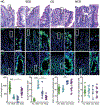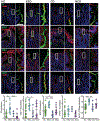Intestinal Epithelial Digestive, Transport, and Barrier Protein Expression Is Increased in Environmental Enteric Dysfunction
- PMID: 36870290
- PMCID: PMC10121737
- DOI: 10.1016/j.labinv.2022.100036
Intestinal Epithelial Digestive, Transport, and Barrier Protein Expression Is Increased in Environmental Enteric Dysfunction
Abstract
Environmental enteric dysfunction (EED) is characterized by malabsorption and diarrhea that result in irreversible deficits in physical and intellectual growth. We sought to define the expression of transport and tight junction proteins by quantitative analysis of duodenal biopsies from patients with EED. Biopsies from Pakistani children with confirmed EED diagnoses were compared to those from age-matched North American healthy controls, patients with celiac disease, and patients with nonceliac disease with villous atrophy or intraepithelial lymphocytosis. Expression of brush border digestive and transport proteins and paracellular (tight junction) proteins was assessed by quantitative multiplex immunofluorescence microscopy. EED was characterized by partial villous atrophy and marked intraepithelial lymphocytosis. Epithelial proliferation and enteroendocrine, tuft, and Paneth cell numbers were unchanged, but there was significant goblet cell expansion in EED biopsies. Expression of proteins involved in nutrient and water absorption and that of the basolateral Cl- transport protein NKCC1 were also increased in EED. Finally, the barrier-forming tight junction protein claudin-4 (CLDN4) was significantly upregulated in EED, particularly within villous enterocytes. In contrast, expression of CFTR, CLDN2, CLDN15, JAM-A, occludin, ZO-1, and E-cadherin was unchanged. Upregulation of a barrier-forming tight junction protein and brush border and basolateral membrane proteins that support nutrient and water transport in EED is paradoxical, as their increased expression would be expected to be correlated with increased intestinal barrier function and enhanced absorption, respectively. These data suggest that EED activates adaptive intestinal epithelial responses to enhance nutrient absorption but that these changes are insufficient to restore health.
Keywords: enteropathy; malabsorption; stunted growth; tight junction; tropical sprue.
Copyright © 2022 United States & Canadian Academy of Pathology. Published by Elsevier Inc. All rights reserved.
Conflict of interest statement
Figures






References
-
- Lin A, Ali S, Arnold BF, et al. Effects of Water, Sanitation, Handwashing, and Nutritional Interventions on Environmental Enteric Dysfunction in Young Children: A Cluster-randomized, Controlled Trial in Rural Bangladesh. Clin Infect Dis 2020; 70:738–747. - PubMed
Publication types
MeSH terms
Substances
Grants and funding
LinkOut - more resources
Full Text Sources
Medical

